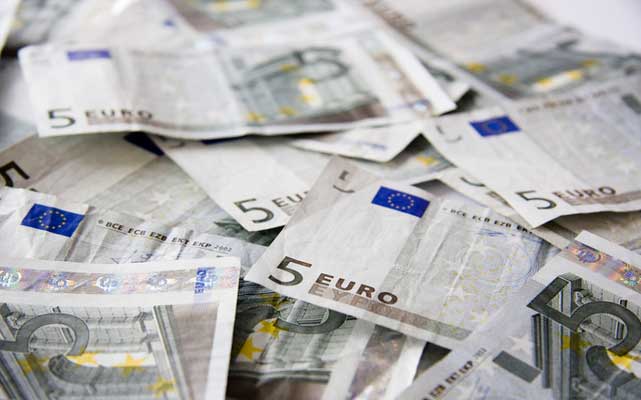Euro to Dollar (EUR/USD) Exchange Rate Forecast 2025: Parity Run Expected
December 31, 2024 - Written by Frank Davies

The US Dollar has seen sustained buying pressure since the November US elections and Trump’s victory. The Euro-to-USD exchange rate (EUR/USD) dipped to two-year lows just below 1.0350 before stabilising.
The consensus is that Trump’s policies will put further upward pressure on the dollar.
Danske Bank expects EUR/USD will retreat to 1.0000 on a 12-month view
Investment banks are reluctant to forecast a slide below parity, but Wells Fargo expects that EUR/USD will trade at 0.98 at the end of 2025.
UBS has adjusted its forecasts slightly, but still expects EUR/USD to recover to 1.10 at the end of 2025.
Investment banks generally expect Administration policies of tax cuts and tariffs will put upward pressure on inflation and prevent further US interest rate cuts.
Tariffs would also tend to undermine the Euro-Zone outlook.
Nordea commented; “We think the dollar will keep dominating the foreign exchange market next year and that the balance of risks point towards further economic divergence that could fuel an even stronger dollar.”
According to Danske Bank; “We maintain a bearish medium-term view on EUR/USD. The US election outcome reinforces our bearish outlook, given anticipated pro-growth and inflationary policies in the US, along with our expectation of relatively stronger US growth dynamics in the coming year.”
MUFG commented; “The 2-year EZ-US swap spread plunged to a new low of - 198bps, surpassing the lows recorded during the post-Ukraine invasion period in 2022 when energy prices in Europe surged. That was when EUR/USD was trading well below the parity level and hence highlights where the risks lie over the coming months.”
MUFG added; “we maintain our view of further US dollar strength in Q1 as Trump tariff announcements coincide with an economic backdrop that reinforce a dollar-supportive divergence in monetary policy.”
Federal Reserve policy will inevitably remain a crucial element.
The Fed cut interest rates by 25 basis points to 4.50% at the final policy meeting of 2024, in line with consensus forecasts.
There was, however, a shift in forecasts from the individual committee members. The median projection is that rates will be cut twice in 2025 compared with a forecast of four cuts in the forecasts released in September.
Markets are now assuming that rates will not be cut in January with the chances of a March cut just under 50%. Only two cuts are priced in for 2025.
MUFG commented; “If economic activity does remain resilient, then the FOMC could be inclined to pause for longer. There is also a tendency for CPI prints to reveal a seasonal upward bias in the first quarter of the year.”
Markets therefore expect yields will continue to support the dollar.
Trade policies will be watched very closely with expectations that the Trump Administration will use tariffs or the threat of tariffs as a key global economic weapon.
Nordea commented; “There is also the potential for an even stronger dollar in the scenario of an aggressive trade war between the US and the rest of the world. Potential tariffs could put downward pressure on already weak economies outside the US and put upward pressure on US inflation, which would increase the odds that the Fed will adopt a hawkish stance.
It added; “We would not be surprised if tariffs would push the dollar below parity versus the euro.”
According to Wells Fargo; “we now expect a more gradual pace of Federal Reserve easing and more accelerated easing from several G10 central banks. In addition, new tariffs enacted under Trump could weigh on the growth prospects of select foreign economies that have higher trade linkages to the United States.”
RBC Capital Markets (RBC) commented; “Post-election it has become consensus that US exceptionalism is here to stay. That is also reflected in positioning which, particularly in G10, has shifted materially towards long USD since November 5.”
It added; “Most parts of Trump’s policy agenda are growth-positive, inflationary or both, so one can understand why US exceptionalism/USD outperformance is consensus. That does not mean it has to be wrong.”
According to HSBC; “We retain our view of USD strength in 2025. This is still largely built on US exceptionalism, notably when compared to Europe. In 2024, that was captured in the shifts in interest rate differentials and echoed in a stronger USD. That has been evident again in the wake of the December FOMC.”
RBC expects some caution from the Administration given the potential domestic impact.
It added; “the message from 2024 elections globally was that voters really do not like inflation and we doubt Trump is ready to deliver policies that crush real US incomes.”
RBC added; “To be clear, we would not rule out briefly trading sub-parity – the same options structures that triggered the quick move to 1.0335 are likely to be replicated lower down and the dealer hedging they entail always runs the risk of short sharp moves lower. But sustaining a move sub-parity is a tall ask.”
UBS is even less confident that Trump policies will boost the dollar; “Markets have so far only incorporated the positive aspects of the Trump trade into the USD. Once he is back in office, we'll find out the reality of his policy proposals—whether they will be implemented or not—and if they'll be as USD-supportive as the market expects.”
It added; “We therefore expect EURUSD to move gradually higher, starting in 2Q.”
There are some concerns that the dollar is overvalued which could trigger selling pressure.
Nordea doubts this would be sufficient to weaken the currency; “One might argue that the dollar is vulnerable to capital outflows because domestic dollar denominated assets have become very expensive compared to foreign asset, but that alone is unlikely to be enough to weaken the dollar on a sustained basis.”
Goldman Sachs added; “we do not think markets have fully incorporated our tariff expectations, and risks to our forecasts are still to the upside over the medium term—despite the Dollar’s lofty valuation.”
The Euro-Zone economy and ECB response will also be important for the pair.
The German and French economies remain weak, and Nordea sees a risk that the ECB might have to cut interest rates to 1.0-1.5%.
There are also important political concerns with deadlock in France after the resignation of Prime Minister Barnier while the German government has also collapsed.
UBS expects Euro fundamentals will improve; “Many of the negative factors that have kept the euro subdued are likely to fade as the year progresses.”
There will be fresh German elections of February 23rd. The CDU is likely to emerge as the largest party, but it will be complicated to put a new coalition together.
There could, however, be a more proactive budget policy and a boost to confidence.
RBC commented; “Germany’s election is likely to usher in easier fiscal policy and a more business-friendly government.”
The bank also considers much of the bad news is priced in; “As its reaction to the collapse of the French govt shows, investors need material new news to send it much lower.”
UBS expects that the ECB will continue to cut rates in the first half of 2025, but signals of a slower pace of cuts are likely in the second quarter while cuts already seen will help cushion activity and spark hopes for a recovery later in the year.
The bank also expects political difficulties to ease and added; “This shift in tone should be a positive catalyst for the euro, especially as we expect the Federal Reserve to pause in January and then re-engage in easing later in 1Q and 2Q.
STORY LINK Euro to Dollar (EUR/USD) Exchange Rate Forecast 2025: Parity Run Expected

The US Dollar has seen sustained buying pressure since the November US elections and Trump’s victory. The Euro-to-USD exchange rate (EUR/USD) dipped to two-year lows just below 1.0350 before stabilising.
The consensus is that Trump’s policies will put further upward pressure on the dollar.
Danske Bank expects EUR/USD will retreat to 1.0000 on a 12-month view
Investment banks are reluctant to forecast a slide below parity, but Wells Fargo expects that EUR/USD will trade at 0.98 at the end of 2025.
UBS has adjusted its forecasts slightly, but still expects EUR/USD to recover to 1.10 at the end of 2025.
Investment banks generally expect Administration policies of tax cuts and tariffs will put upward pressure on inflation and prevent further US interest rate cuts.
Tariffs would also tend to undermine the Euro-Zone outlook.
Nordea commented; “We think the dollar will keep dominating the foreign exchange market next year and that the balance of risks point towards further economic divergence that could fuel an even stronger dollar.”
According to Danske Bank; “We maintain a bearish medium-term view on EUR/USD. The US election outcome reinforces our bearish outlook, given anticipated pro-growth and inflationary policies in the US, along with our expectation of relatively stronger US growth dynamics in the coming year.”
MUFG commented; “The 2-year EZ-US swap spread plunged to a new low of - 198bps, surpassing the lows recorded during the post-Ukraine invasion period in 2022 when energy prices in Europe surged. That was when EUR/USD was trading well below the parity level and hence highlights where the risks lie over the coming months.”
MUFG added; “we maintain our view of further US dollar strength in Q1 as Trump tariff announcements coincide with an economic backdrop that reinforce a dollar-supportive divergence in monetary policy.”
Federal Reserve policy will inevitably remain a crucial element.
The Fed cut interest rates by 25 basis points to 4.50% at the final policy meeting of 2024, in line with consensus forecasts.
There was, however, a shift in forecasts from the individual committee members. The median projection is that rates will be cut twice in 2025 compared with a forecast of four cuts in the forecasts released in September.
Markets are now assuming that rates will not be cut in January with the chances of a March cut just under 50%. Only two cuts are priced in for 2025.
MUFG commented; “If economic activity does remain resilient, then the FOMC could be inclined to pause for longer. There is also a tendency for CPI prints to reveal a seasonal upward bias in the first quarter of the year.”
Markets therefore expect yields will continue to support the dollar.
Trade policies will be watched very closely with expectations that the Trump Administration will use tariffs or the threat of tariffs as a key global economic weapon.
Nordea commented; “There is also the potential for an even stronger dollar in the scenario of an aggressive trade war between the US and the rest of the world. Potential tariffs could put downward pressure on already weak economies outside the US and put upward pressure on US inflation, which would increase the odds that the Fed will adopt a hawkish stance.
It added; “We would not be surprised if tariffs would push the dollar below parity versus the euro.”
According to Wells Fargo; “we now expect a more gradual pace of Federal Reserve easing and more accelerated easing from several G10 central banks. In addition, new tariffs enacted under Trump could weigh on the growth prospects of select foreign economies that have higher trade linkages to the United States.”
RBC Capital Markets (RBC) commented; “Post-election it has become consensus that US exceptionalism is here to stay. That is also reflected in positioning which, particularly in G10, has shifted materially towards long USD since November 5.”
It added; “Most parts of Trump’s policy agenda are growth-positive, inflationary or both, so one can understand why US exceptionalism/USD outperformance is consensus. That does not mean it has to be wrong.”
According to HSBC; “We retain our view of USD strength in 2025. This is still largely built on US exceptionalism, notably when compared to Europe. In 2024, that was captured in the shifts in interest rate differentials and echoed in a stronger USD. That has been evident again in the wake of the December FOMC.”
RBC expects some caution from the Administration given the potential domestic impact.
It added; “the message from 2024 elections globally was that voters really do not like inflation and we doubt Trump is ready to deliver policies that crush real US incomes.”
RBC added; “To be clear, we would not rule out briefly trading sub-parity – the same options structures that triggered the quick move to 1.0335 are likely to be replicated lower down and the dealer hedging they entail always runs the risk of short sharp moves lower. But sustaining a move sub-parity is a tall ask.”
UBS is even less confident that Trump policies will boost the dollar; “Markets have so far only incorporated the positive aspects of the Trump trade into the USD. Once he is back in office, we'll find out the reality of his policy proposals—whether they will be implemented or not—and if they'll be as USD-supportive as the market expects.”
It added; “We therefore expect EURUSD to move gradually higher, starting in 2Q.”
There are some concerns that the dollar is overvalued which could trigger selling pressure.
Nordea doubts this would be sufficient to weaken the currency; “One might argue that the dollar is vulnerable to capital outflows because domestic dollar denominated assets have become very expensive compared to foreign asset, but that alone is unlikely to be enough to weaken the dollar on a sustained basis.”
Goldman Sachs added; “we do not think markets have fully incorporated our tariff expectations, and risks to our forecasts are still to the upside over the medium term—despite the Dollar’s lofty valuation.”
The Euro-Zone economy and ECB response will also be important for the pair.
The German and French economies remain weak, and Nordea sees a risk that the ECB might have to cut interest rates to 1.0-1.5%.
There are also important political concerns with deadlock in France after the resignation of Prime Minister Barnier while the German government has also collapsed.
UBS expects Euro fundamentals will improve; “Many of the negative factors that have kept the euro subdued are likely to fade as the year progresses.”
There will be fresh German elections of February 23rd. The CDU is likely to emerge as the largest party, but it will be complicated to put a new coalition together.
There could, however, be a more proactive budget policy and a boost to confidence.
RBC commented; “Germany’s election is likely to usher in easier fiscal policy and a more business-friendly government.”
The bank also considers much of the bad news is priced in; “As its reaction to the collapse of the French govt shows, investors need material new news to send it much lower.”
UBS expects that the ECB will continue to cut rates in the first half of 2025, but signals of a slower pace of cuts are likely in the second quarter while cuts already seen will help cushion activity and spark hopes for a recovery later in the year.
The bank also expects political difficulties to ease and added; “This shift in tone should be a positive catalyst for the euro, especially as we expect the Federal Reserve to pause in January and then re-engage in easing later in 1Q and 2Q.
International Money Transfer? Ask our resident FX expert a money transfer question or try John's new, free, no-obligation personal service! ,where he helps every step of the way, ensuring you get the best exchange rates on your currency requirements.
Comments are currrently disabled
Related Stories:
- Euro to Dollar (EUR/USD) Exchange Rate Forecast 2025: Parity Run Expected - December 31, 2024
- Pound to Dollar Rate Predictions Next Year: Waves of Uncertainties Surround 2025 - December 31, 2024
- Pound to Euro Forecasts for 2025: 8-Year Best Ahead for GBP/EUR - December 30, 2024
- Pound to Euro Rate End-of-Year Forecast: Steady Path to 1.25 in 2025 - December 22, 2024
- Pound to Dollar Rate 2025 Forecast: Plunge to 1.17 or Rally to 1.38? - December 22, 2024
- Pound to Dollar Rate December Forecast: 2025 - a Year of Uncertainty - December 15, 2024
- Pound to Euro Rate Forecast for Week Ahead: Make or Break for Sterling Rates - December 15, 2024
- Pound to Dollar Week Ahead Exchange Rate Forecast: Recovery? - December 8, 2024
- Pound to Euro Rate Week Ahead Forecast: Push to €1.21 - December 8, 2024
Latest News:
- Pound Sterling: Damage to Technical Outlook say Analysts - January 3, 2025
- British Pound Sterling Slides Against Euro and Dollar on 2025 UK Stagnation Fears - January 2, 2025
- Pound to Dollar Rate Predictions Next Year: Waves of Uncertainties Surround 2025 - December 31, 2024
- US Dollar to Yen Forecast: Clash of Economics and Politics, 140 or 160 in 12 months - December 31, 2024
- Euro to Dollar (EUR/USD) Exchange Rate Forecast 2025: Parity Run Expected - December 31, 2024
- Pound to Euro Forecasts for 2025: 8-Year Best Ahead for GBP/EUR - December 30, 2024
- Pound to Euro Rate in Mysterious 2% JUMP on Christmas Day - December 25, 2024
- Pound to Dollar Rate 2025 Forecast: Plunge to 1.17 or Rally to 1.38? - December 22, 2024
- Pound to Euro Rate End-of-Year Forecast: Steady Path to 1.25 in 2025 - December 22, 2024
- Pound Sterling Dips Against Euro and Dollar on Surprise BoE Vote Split - December 20, 2024









